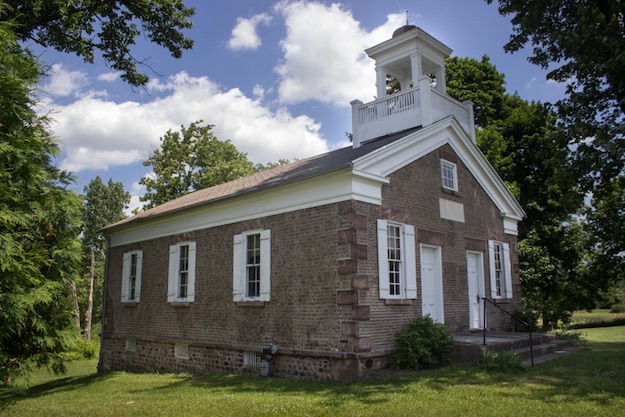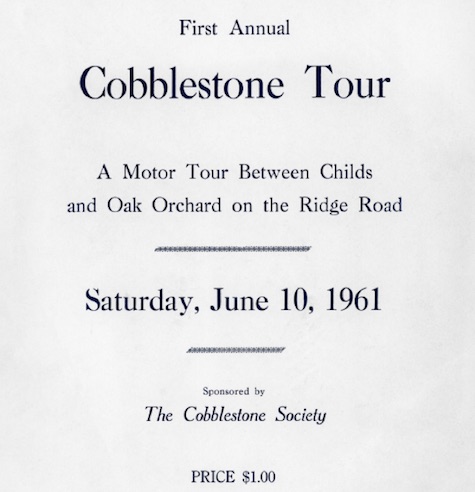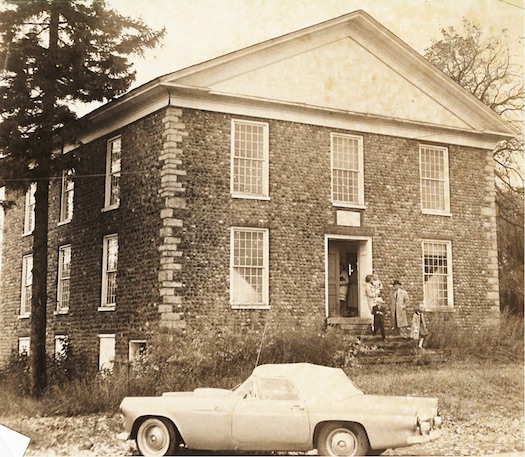Historic Childs: Forming the Cobblestone Society
By Doug Farley, Cobblestone Museum Director – Vol. 2 No. 30
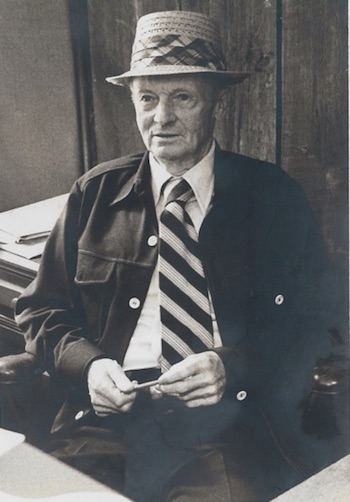
Cary Lattin
GAINES – Most local residents probably don’t remember a time before the Cobblestone Society existed. Nearly everyone in the vicinity can remember a school field trip to the Cobblestone Museum, or has attended an Old Timers Fair or two over the years. But truth be told, there was a definite beginning to the Cobblestone Society and a dedicated team of individuals who created a reality from a dream.
The rest of this article is taken from an interview with Historian Cary Lattin, as shown above, on July 24, 1979, undertaken by Orleans County Historical Association (OCHA) in an effort to record the collective memory of the county’s leading pioneers from the late 19th century and early 20th century. The full audio recording of Mr. Lattin’s interview is available in local libraries and also can be view online using this link.
Forming the Cobblestone Society, as told by Cary Lattin
I’ll try and tell a little bit about the history of the Cobblestone Society, why it was formed and how it was formed during the year 1959, when Gaines had the Sesquicentennial celebration, there was going to be a one day celebration or fair. It took about two months to get ready for this Sesquicentennial celebration.
We wanted to visit the points of interest around the town and we wanted to visit the Cobblestone Church at Childs. We went to the Universalist Board in Albion and asked them if they would open the church for one day so we could see the interior of this beautiful old Cobblestone Church. Two or three of us went down to the church and word came ’round, and we went through the building.
The plaster was bad in the ceiling and it was in kind of rough shape. There were many windows that were broken and the Universalist Board decided that it would be risky to have a bunch of children running around in the church. They might jar some plaster and break somebody’s glasses! So we didn’t have the Church to visit. During the Centennial, and after the Centennial, people commenced to ask, “What’s going to happen to the old church?”
When you tell a damn Yankee that he can’t have something, hell is out for dinner-time. Then they want it! They learned that in Prohibition. When they told the American people they couldn’t have booze, they got booze, one way or another. So, people in the neighborhood were concerned. People in the district were concerned, and in the town. “What’s going to happen to this old beautiful church? We had no organization formed that· could maintain the building or had no Society formed that could operate the thing like it is today.
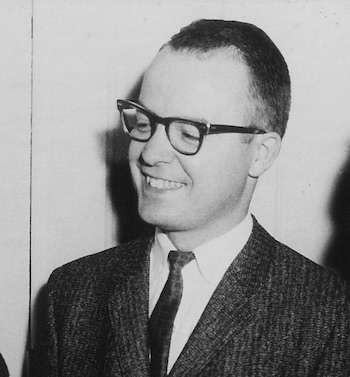
Bob Frasch, 1961
During the winter of 1959 and 1960, Bob Frasch taught school in Holley, history and English, and he formed a Yorker Club in the Holley High School. One of the projects was to find the cobblestone houses in the Town of Murray and get all the information on these 14 cobblestone houses in Murray. There wasn’t too much information available.
He came into the office when I was County Historian and asked me what I knew about a cobblestone house. I said, “I have lived in on one for about 60 years. And by way of talking about cobblestone buildings, there’s a beautiful church building in Childs.” He said, “Let’s go see it.” So we proceeded to go down to Childs, stopping by Homer Brown’s house to get the key to the church. When Bob Frasch saw the interior of this old Cobblestone Church, he really flipped! He said, “This building should be saved.” I said, “Yes, I know it should be saved but how are you going to save it? We have no organization whatsoever to do this. We have no money.”
Well, people commenced to get concerned. The Historian of the Town of Albion, Katharine Billings, whose ancestors had been attendants of this church and the Historian of the Town of Gaines, Howard Pratt were interested. And that’s the way it hung fire. The next fall in 1960, Charlie Thompson called me one morning about six o’clock and said, “Say, they are going to sell the Cobblestone Schoolhouse. We better do something about it.” So I went down to see Charlie, and he said all the district schools have been centralized in the five schools in Orleans County, Kendall, Holley, Albion, Medina, and Lyndonville.
He says, “You know they are going to sell this building next week Tuesday at Albion Central School. They are going to dispose of it.” “Well,” I said, “Charlie, will you go up to the meeting? You can vote. Vote against selling it; to hold us on the table for six months until we can do something?” And he said, “Sure.” So I took it upon myself to go and see about 12 or 14 people in the immediate district, Gaines #5, to see if they would go to the Albion Central School meeting and see if we couldn’t save this, stall this off, for four or five or six months until we could get an organization.”
Bob Frasch and I went to the meeting and asked if we could be heard, and we both talked about holding this up until an organization could be formed. Our main purpose was to save the Cobblestone Church and the Cobblestone School. We gave them a pitch and they listened. Walter Balcom was there. He had gone to school at this Cobblestone School. He had attended the Cobblestone Church when they had their meetings there twice each summer. He had a very fine vocabulary of four-letter-words. He got up and said, “I make a blankety-blank motion that this blankety-blank schoolhouse be left on the table for six months, and if you blankety-blank guys can’t get organized in that time, you don’t deserve the damn school!”
And, they voted unanimously to hold the sale up for six months. They tossed us a torch and then we had to do something. So we got an ad hoc committee, so to speak. We had no money. We had no funds, we had nothing! And on this, we wrote a letter, Bob Frasch, it was in his writing. And, we got Katharine Billings, the Albion Historian, and Howard Pratt, who was Gaines Town Historian, and Morris Wilson, who lived next door to the Church and one or two others. Bob Frasch and the committee and myself, signed this letter. We sent this letter out to 100 people. We went through the telephone directory and looked in there and saw names of people we thought would be interested in saving their heritage. Well, the meeting was called at three o’clock on a cold Sunday afternoon in October 1960.
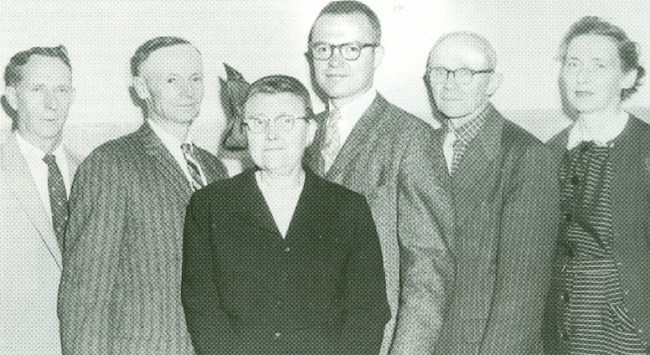
Some of the first officers and directors of the Cobblestone Society in 1960: (left) Maurice Wilson, Vice-President; Cary H. Lattin, Director; Katherine Billings, Secretary; Robert Frasch, President; J. Howard Pratt, Director; and Hannah Thompson, Treasurer.
You know there were 65 people showed up at that meeting, and we had a slate of officers drawn up. We’d asked all these people if they’d either be a director or an officer, and we told them what we wanted to do at this meeting. There were about 60 people signed up to be members. Some of them paid the $2.00 dues right then. So, we had the thing started. We agreed to meet at the Village Inn in about two weeks and get an organizational meeting. We had a dinner meeting over at the Village Inn and we had the west room pretty well filled up.
There were probably 89 to 100 people there who were interested in saving this building. Carl Schmidt was there. He was also at the first meeting. He had written a book about cobblestone buildings in 1944. The little books that he wrote in 1944 are collector’s items today. So, we had a slate of officers drawn up. We had a cross section of our people, we had an attorney, we had two architects, we had school teachers, we had farmers, and we had businessmen on this thing. We had a cross section of what was going on. With the help of the attorney and Bob Frasch, they came up with a set of by-laws and a constitution.
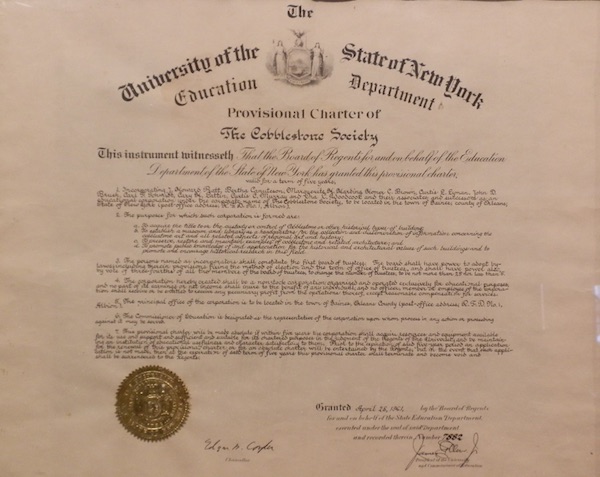
State Education Department Charter
We asked for a charter from the New York State Department of Education. And we were wise. That was our attorney’s advice. “Get this charter from the state Department of Education if you possibly can.” So we had the application for a charter and it was signed by, I think, the directors and the officers. By the end of the six months we had a temporary charter.
So, when the school-house came up for sale, the next April, that was in 1961, we had $129.00 in our fat little hands to pay for the school- house! That’s what we had to pay for deeds and search and the necessary proper papers that has to be signed to transfer the property. So we owned the building.
We were in business. Carl Schmidt came up with the idea that we would have a tour that spring, 1961. And, we held a Cobblestone Tour and made money. It was held right around this vicinity. That fall we had an auction in the schoolhouse to make money, but our main concern was to save the church. We made some overtures to the Universalist Board in Albion, and they were in our corner, so to speak.
John Brush, who was a director on our society, was in the hierarchy of the State Universalist Convention and his influence didn’t hurt a bit. He was a trustee of St. Lawrence University. He has endowed St. Lawrence University very well. It took about two or three years before the final papers came through. After the papers were signed by the Universalist State Convention and the Universalists over here had relinquished what they had in the building, it seems that they sat for six months in Judge Serve’s office. I saw him one day in the courthouse hall and I said, “You know, Judge, why don’t you hurry that up a little bit? We want to get title to that building and we want to do things!” He said, “You know, Cary, don’t try to coerce a Supreme Court Judge. I wouldn’t want to put you in jail.”
So, in about three years we got clear title to the Cobblestone Church in Childs. We were in business for real. The Cobblestone Society put a roof on that building that cost $2,200 before we owned it. That’s how much we thought of the building. So then we had two buildings.
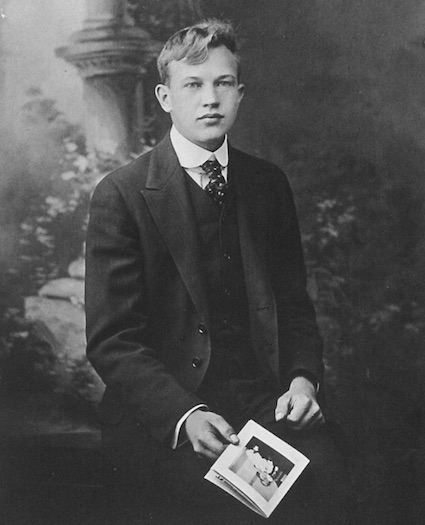
John Brush, early 1900s
Well, our angel, John Brush, is a good friend of mine. I’ve known him as long as I’ve known anybody around Albion High School, and he is a fairly wealthy man. I said, “You know one day we should restore the tower.” There was a tower on that church when it was first built. The tower was removed in 1918 because it was getting deteriorated. The timbers were rotten. So, the Universalist Society decided to take the tower off. And, John Brush said, “I think so too, and I will pay for it.”
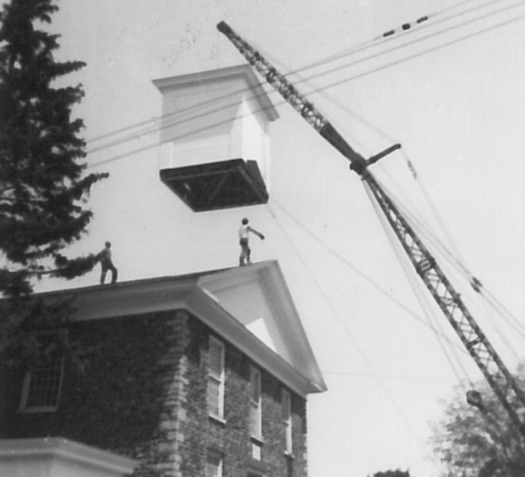
Cobblestone Church tower restoration, 1966
So, John and I went to see Hobart Snell who was the only contractor close by, and John and Hobart made a deal, and the tower was restored. And John Brush paid for it himself. I remember when he was up there the terrace in front of the church was in bad shape when we bought the church. They were all covered over with woodbine. Nobody knew there was a terrace there, just thought there were some steps going up there.
So one day when there were some of the directors down there, we decided to pull up some of the woodbine, and discovered there was a terrace. It looked pretty crummy. One day John said, “I think we better do some repair on the front of the church. I will repair the terrace and furnish some landscaping.”
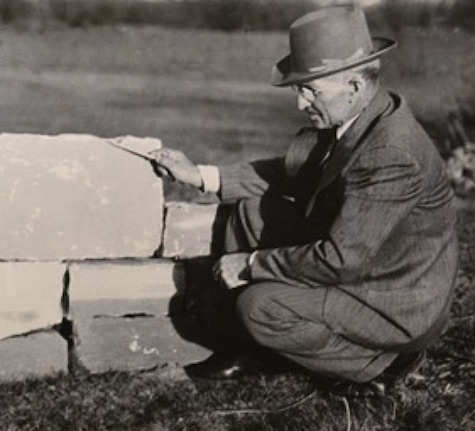
Pasquale DiLaura
So, we went to see “Pat” (Pasquale) DiLaura, who was the last of the Orleans County quarrymen. He was as fine a gentleman as I ever hoped to know. “Pat” DiLaura was Mr. Stone Quarry, Medina Sandstone.
He was 80 years old at the time, and he said he would take upon the job of restoring the terrace. He still had some influence at the quarries in Hulberton, and he went down there with some of his trucks and got a couple loads of stone to re-lay this terrace. With his stonecutter helper, Sandy Malone, “Pat” DiLaura re-laid the stone.
Frankie Swierczynski let us have four or five of his boys over there to do the grub work. They had to dig out the trench and do some of the heavy lifting. There was “Pat” DiLaura and Sandy Malone that made the terrace and that was laid in 1966. It looked pretty nice. These shrubs that were replanted, came from a nursery up in Newfane, and that first summer they were planted there, they guaranteed these shrubs to live. I said, “That’s awful nice, to guarantee these shrubs!” However, he said, “You got to water them this summer.”
I watered them 27 times that summer. I got water for free from Hank Radzinski’s spigot. You know, neighbors are better than money sometimes. When Hank Radzinski was going to get his license for a Liquor store, right next to the church, he was having problems. The Secretary of the Orleans County Liquor Authority came to me and said, “How many times are you going to have service in your church?” It wasn’t my church and I wasn’t having the service, but that’s what he said. I said, “We don’t know whether we would have any service.” “You know,” he said, “Hank is going to have problems getting a liquor store next to a church.” I said, “If you talk to any Cobblestoner and they try to do anything to stop his liquor store, clobber them!” I told Howard Pratt, and I told a couple of others, “If they wanted to have a liquor store there, he is going to get it. Let’s have his good will.”
So we had his good will. When we wanted water, we had thousands and thousands of gallons of water. I talked to Hank about it and he said, “I know it. I appreciate what you guys didn’t do.” So we were in business.






























